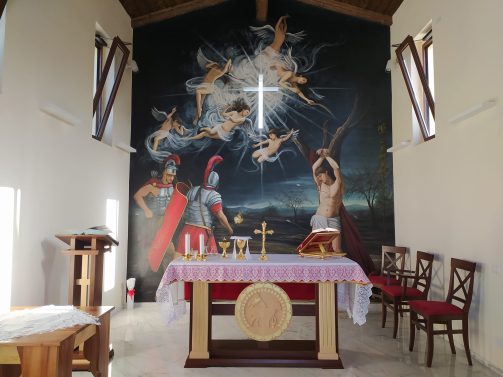It was dedicated to St. Sebastian, a Christian martyr protector against the plague, who lived between 263 and 304, perhaps as a result of grace received by the people of Segary who survived the plague epidemics that followed in those years.
As a bequest and ecclesiastical possession in its founding nothing so far is clear, certain is that it dates back several centuries.
Its designation as a chapel suggests that in ancient times the little church of the saint was used as a chapel by some confraternity formed or founded in honor of the martyr saint, where in ancient times the annual feast was completely held.
It was located in what is now St. Sebastian Square, on a small hill overlooking the town to the east called Hare Mountain. It was 17 meters long, 4.20 meters wide, 3.60 meters high, and paved with Sardinian tiles from Segariu.
It had two doors and three windows, a single nave, and a bell gable; around the church was the cemetery, enclosed by a wall on three sides and a hedge of brambles in the part facing the town.
The façade had a flat finial surmounted by a single-arched bell gable and a large architraved portal with a cornice; it was also divided into mirrors of large perpendicular pilasters just protruding from the wall; immediately above the architrave was the only semioval window in the building, which probably also served as a drain.
Surveys still show the ancient foundations of the church, and of the cemetery a small section of the wall leaning against the fences of the new houses.
In 1645 the church of St. Sebastian was mistakenly named the parish church in the confirmation register.
In 1804 the marble-effect painted altar was built by priest Louis Gabriel, surmounted by the niche for the saint, and on either side are depicted two jailers (for some they are Saints Cosmas and Damian) converted with their wives.
In 1805, more graves could be built in the daughter church and burials could take place.
In 1821 the completion of the surrounding wall was ordered by the bishop; until 1880 in the basement called “Sa Tumba” the town’s notables were buried for a fee.
In 1866 the church and cemetery became the property of the municipality and were used for burials and for the Saint’s feast on January 20.
In 1934 the closure of the cemetery occurred with the transportation of some graves and bones to the new cemetery.
In 1959 the church was declared to be in ruins.
In 1968 the demolition of the church will take place in the last months of the year.
In 1985 the construction of the square.
In 2022 it is rebuilt alongside the old foundation.










